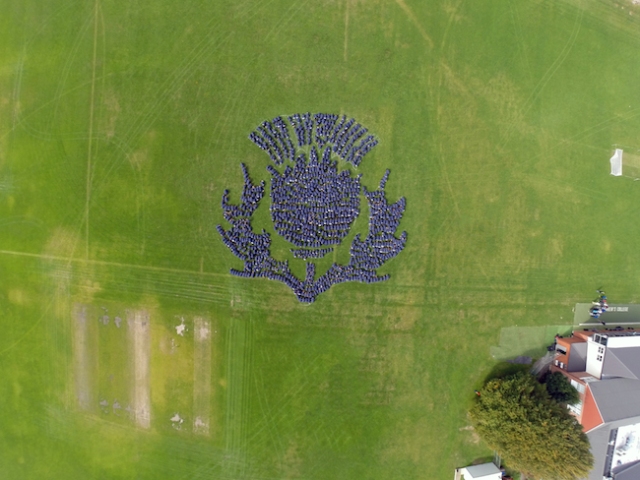Throughout Term 2 there had been whispers around the College of an ambitious media project being planned by Mr Simon Williams (Head of Media) that would involve collaboration between his Year 12 media students and a group of students from the Preparatory School.
The end product was called Fusion, and involved 19 Year 12 students, 42 Year 6 students, 8 TV cameras, 3 recording studios and an Outside Broadcast van to co-ordinate it all. Filmed over the course of a single day, the show incorporated a number of live acts alongside three children’s television items planned, filmed and edited earlier that were to be assessed along with the live show. Together, these formed the major NCEA Level 2 assessment for the Year 12 students of:
- AS91252 (2.5) Produce a design and plan for a developed media product using a range of conventions
- AS91253 (2.6) Complete a developed media product from a design and plan using a range of conventions
Background:
For a number of years now the Year 12 Media Studies class had produced a children’s programme for this assessment, but this year Mr Williams decided to see if the Preparatory School wanted to be involved in a collaboration of the actual making of the show, rather than just being the intended audience. After talking with Mrs Di Cumming and Mr Wilj Dekkers, it was quickly decided that the Year 6 students would be willing participants and that the theme of the live show should be based around China, a unit that the Year 6 students had recently been studying.
This theme was met with initial resistance by the Year 12 students, however they quickly came around to the idea as it would provide an authentic context within which their individual programmes could be incorporated through the live broadcast. These individual programmes would reflect the areas of learning of the Preparatory students and included:
- Chinese paper cutting
- Calligraphy
- Dumpling making
- Kung Fu
- Fan dancing
To help out, volunteers from the Confucius Institute at the University of Canterbury agreed to come along on the day and provide guidance to the students.
The 42 Year 6 students were divided into four groups, three groups working individual programmes as part of the show and the remaining ten students helping out with the recording and broadcasting aspects of the production.
Recording The Show:
Whilst recording live studios is regularly done at St Andrew’s College, it is normally managed from within the one studio in the Secondary School. To make this a truly collaborative project with the Preparatory School, Mr Williams decided to run a second studio from within one of the downstairs open learning spaces in the Preparatory School that you can explore here (the recording was done where the chess pieces are visible):
To co-ordinate this venture, Mr David Jensen (who helped record an early Mystery Skype by Year 3 students) was parked in the Outside Broadcast van giving directions to the various camera operators, floor controllers and presenters of the different studios. To further support the show, a number of Old Collegians with experience in the Media Studio returned to support Mr Williams and the students, further highlighting how collaborative projects like this can truly engage the community and generate very authentic learning opportunities for our students.
Throughout the recording of the show, there were a number of challenges that required the students to think on their feet and try to resolve the problems themselves. When some turned to Mr Williams for advice, he encouraged them to make decisions, reminding them that they had more information as floor managers and presenters of their various programmes than he necessarily did at that point in time. A number of the Year12 students commented afterwards that they did not think they had worked so hard in their lives, yet they thoroughly enjoyed the experience of creating a live production.
Fusion – The Show:
Some short cuts to different sections of the show are below:
- Calligraphy Section
- Bracelet Making Section
- Learning Mandarin Section
- Cooking Dumplings Section
- Chinese Fan Dance Section
As you can see, not all of the transitions between the various components of the show and studios worked seamlessly – however it is precisely this type of live show that allows students to learn and understand the teamwork required to produce a quality live performance.
Reflecting On The Show:
Mrs Cummings provided some reflections from the Preparatory perspective as well, commenting that:
- [The] children were incredibly excited about just working in the secondary school itself.
- All children thoroughly enjoyed working with the year 12 students… this [is] beneficial in breaking down any anxieties about these ‘big people’. We often take for granted that because we are all on the same site that this will occur almost through osmosis but it does need to be planned for too.
- The children were absolutely exhausted afterwards … I cannot recall a time when we have all been so tired. This reflects the intensity of what occurred and how involved the children were.
- The children had to cope with change due to the nature of the live broadcast.
- It provided very real purpose to the learning and children knew they were working to a deadline with their inquiries.
- Many of the positive outcomes were those we could not have planned for – the feelings of urgency, the degree of collaboration, the opportunities for leadership, etc.
Mr Williams also commented that:
Most schools simply study films for their Media Studies classes. A real point of difference at St Andrew’s College is that students can actually be involved in making live shows such as this one – it is realistic, fun and gives them experiences that make them want to continue studying Media and potentially working in it when they leave school.
Behind the Scenes – The Making Of Fusion:















